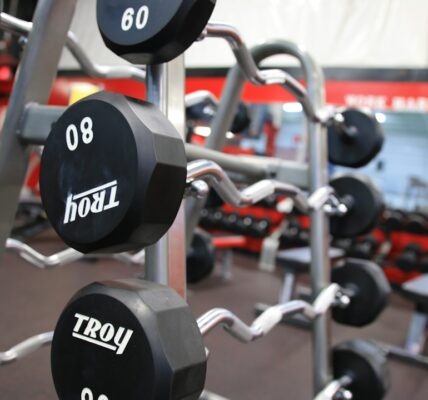Setting realistic health goals is crucial for achieving a healthier lifestyle. It is essential to accurately assess your current health and fitness status and establish achievable, sustainable objectives. Goals may include weight loss, muscle gain, improved cardiovascular health, or overall well-being.
Utilizing the SMART (Specific, Measurable, Attainable, Relevant, Time-bound) framework can help create effective goals. For instance, rather than a vague goal like “lose weight,” a SMART goal would be “lose 10 pounds in 3 months by exercising 4 times weekly and improving dietary choices.” This approach allows for progress tracking and maintains motivation. When setting health goals, it is important to consider your current lifestyle and commitments.
For those with busy schedules, starting with 30 minutes of exercise three times a week and gradually increasing frequency may be more realistic than committing to daily hour-long sessions. Additionally, physical limitations and health conditions should be taken into account. For example, individuals with knee pain might focus on improving knee strength and flexibility through targeted exercises rather than setting a goal to run a marathon.
Ultimately, setting realistic health goals involves self-honesty, consideration of current lifestyle factors, and establishing SMART objectives that align with overall health and fitness aspirations. This approach increases the likelihood of success and sustainable long-term health improvements.
Key Takeaways
- Setting realistic health goals is important for long-term success and sustainability.
- Creating a personalized fitness plan tailored to individual needs and preferences is key for adherence.
- Understanding the importance of nutrition and its impact on overall health and fitness goals is crucial.
- Incorporating both strength training and cardio into a fitness routine is essential for balanced physical development.
- Utilizing technology for tracking progress can provide valuable insights and motivation for continued improvement.
Creating a Personalized Fitness Plan
Understanding Your Fitness Goals
When creating a fitness plan, it’s important to incorporate a variety of exercises that target different muscle groups and aspects of fitness such as strength, flexibility, and cardiovascular endurance. This could include a combination of strength training, cardio exercises, and flexibility exercises such as yoga or Pilates.
Customizing Your Workout Routine
In addition to incorporating a variety of exercises, it’s important to consider the frequency and intensity of your workouts. For example, if your goal is to build muscle, you may need to incorporate strength training exercises 3-4 times a week with higher intensity and lower repetitions. On the other hand, if your goal is to improve cardiovascular endurance, you may need to incorporate cardio exercises such as running or cycling at a moderate intensity for 30-60 minutes several times a week.
Making It Enjoyable and Sustainable
When creating a personalized fitness plan, it’s also important to consider activities that you enjoy and that fit into your lifestyle. If you don’t enjoy running, there’s no need to force yourself to do it. Instead, you could try swimming, dancing, or hiking as alternative forms of cardio exercise. By incorporating activities that you enjoy, you’re more likely to stick with your fitness plan long-term.
Understanding the Importance of Nutrition

Understanding the importance of nutrition is crucial for achieving optimal health and fitness. Nutrition plays a key role in fueling our bodies for exercise, aiding in recovery after workouts, and supporting overall health. A balanced diet that includes a variety of nutrients such as carbohydrates, protein, healthy fats, vitamins, and minerals is essential for providing the energy needed for physical activity and supporting muscle growth and repair.
In addition to fueling our bodies for exercise, nutrition also plays a crucial role in weight management and overall health. Consuming whole foods such as fruits, vegetables, lean proteins, whole grains, and healthy fats can help maintain a healthy weight and reduce the risk of chronic diseases such as heart disease and diabetes. It’s important to be mindful of portion sizes and to listen to our body’s hunger and fullness cues in order to maintain a healthy balance.
Understanding the importance of nutrition also involves being aware of how different foods can impact our energy levels and performance during exercise. For example, consuming complex carbohydrates such as whole grains and starchy vegetables before a workout can provide sustained energy for longer duration activities. On the other hand, consuming protein-rich foods after a workout can aid in muscle recovery and repair.
Overall, understanding the importance of nutrition involves fueling our bodies for exercise, supporting overall health and weight management through a balanced diet rich in nutrients. Understanding the importance of nutrition is crucial for achieving optimal health and fitness. Nutrition plays a key role in fueling our bodies for exercise, aiding in recovery after workouts, and supporting overall health.
A balanced diet that includes a variety of nutrients such as carbohydrates, protein, healthy fats, vitamins, and minerals is essential for providing the energy needed for physical activity and supporting muscle growth and repair. In addition to fueling our bodies for exercise, nutrition also plays a crucial role in weight management and overall health. Consuming whole foods such as fruits, vegetables, lean proteins, whole grains, and healthy fats can help maintain a healthy weight and reduce the risk of chronic diseases such as heart disease and diabetes.
It’s important to be mindful of portion sizes and to listen to our body’s hunger and fullness cues in order to maintain a healthy balance. Understanding the importance of nutrition also involves being aware of how different foods can impact our energy levels and performance during exercise. For example, consuming complex carbohydrates such as whole grains and starchy vegetables before a workout can provide sustained energy for longer duration activities.
On the other hand, consuming protein-rich foods after a workout can aid in muscle recovery and repair. Overall, understanding the importance of nutrition involves fueling our bodies for exercise, supporting overall health and weight management through a balanced diet rich in nutrients.
Incorporating Strength Training and Cardio
| Metrics | Strength Training | Cardio |
|---|---|---|
| Increased muscle mass | Yes | No |
| Improved cardiovascular health | No | Yes |
| Enhanced metabolism | Yes | Yes |
| Weight management | Yes | Yes |
Incorporating both strength training and cardio into your fitness routine is essential for achieving overall health and fitness goals. Strength training helps build lean muscle mass which can increase metabolism and improve body composition. It also helps strengthen bones and joints which can reduce the risk of injury as well as improve functional strength for everyday activities.
Strength training exercises can include bodyweight exercises such as squats and push-ups or using resistance bands or free weights. On the other hand, cardio exercises such as running, cycling or swimming are important for improving cardiovascular endurance which can reduce the risk of heart disease as well as improve overall stamina for daily activities. Cardio exercises also help burn calories which can aid in weight management as well as improve mood by releasing endorphins.
Incorporating both strength training and cardio into your fitness routine allows for a well-rounded approach to overall health and fitness by targeting different aspects such as muscle strength and endurance. It’s important to find a balance between the two types of exercise based on individual goals and preferences in order to achieve optimal results. Incorporating both strength training and cardio into your fitness routine is essential for achieving overall health and fitness goals.
Strength training helps build lean muscle mass which can increase metabolism and improve body composition. It also helps strengthen bones and joints which can reduce the risk of injury as well as improve functional strength for everyday activities. Strength training exercises can include bodyweight exercises such as squats and push-ups or using resistance bands or free weights.
On the other hand, cardio exercises such as running, cycling or swimming are important for improving cardiovascular endurance which can reduce the risk of heart disease as well as improve overall stamina for daily activities. Cardio exercises also help burn calories which can aid in weight management as well as improve mood by releasing endorphins. Incorporating both strength training and cardio into your fitness routine allows for a well-rounded approach to overall health and fitness by targeting different aspects such as muscle strength and endurance.
It’s important to find a balance between the two types of exercise based on individual goals and preferences in order to achieve optimal results.
Utilizing Technology for Tracking Progress
Utilizing technology for tracking progress can be an effective tool for staying motivated and accountable towards achieving health goals. There are various apps available that can help track physical activity such as steps taken per day or calories burned during workouts which can provide insight into overall activity levels. Additionally there are apps that can track food intake which can help monitor nutrient intake as well as calorie consumption.
Fitness trackers are another form of technology that can provide real-time data on physical activity levels throughout the day including heart rate monitoring during workouts which can help gauge intensity levels during exercise sessions. These devices can also track sleep patterns which is an important aspect of overall health that can impact energy levels throughout the day. Utilizing technology for tracking progress can provide valuable data that can help make informed decisions towards achieving health goals by providing insight into activity levels as well as nutrient intake which can help make adjustments towards reaching specific targets.
Utilizing technology for tracking progress can be an effective tool for staying motivated and accountable towards achieving health goals. There are various apps available that can help track physical activity such as steps taken per day or calories burned during workouts which can provide insight into overall activity levels. Additionally there are apps that can track food intake which can help monitor nutrient intake as well as calorie consumption.
Fitness trackers are another form of technology that can provide real-time data on physical activity levels throughout the day including heart rate monitoring during workouts which can help gauge intensity levels during exercise sessions. These devices can also track sleep patterns which is an important aspect of overall health that can impact energy levels throughout the day. Utilizing technology for tracking progress can provide valuable data that can help make informed decisions towards achieving health goals by providing insight into activity levels as well as nutrient intake which can help make adjustments towards reaching specific targets.
Overcoming Plateaus and Staying Motivated

Overcoming plateaus is common when working towards health goals but there are strategies that can help break through these periods of stagnation in progress. One approach is changing up workout routines by incorporating new exercises or increasing intensity levels which can challenge muscles in new ways leading to progress towards building strength or endurance. Another approach is focusing on recovery by incorporating rest days into workout routines which allows muscles time to repair leading to improved performance during subsequent workouts.
Additionally incorporating stress-reducing activities such as yoga or meditation can help manage cortisol levels which can impact recovery from workouts. Staying motivated towards achieving health goals involves finding activities that are enjoyable which can help maintain consistency long-term towards reaching specific targets. Setting short-term achievable goals along the way towards larger objectives can provide motivation by celebrating small victories along the way.
Overcoming plateaus is common when working towards health goals but there are strategies that can help break through these periods of stagnation in progress. One approach is changing up workout routines by incorporating new exercises or increasing intensity levels which can challenge muscles in new ways leading to progress towards building strength or endurance. Another approach is focusing on recovery by incorporating rest days into workout routines which allows muscles time to repair leading to improved performance during subsequent workouts.
Additionally incorporating stress-reducing activities such as yoga or meditation can help manage cortisol levels which can impact recovery from workouts. Staying motivated towards achieving health goals involves finding activities that are enjoyable which can help maintain consistency long-term towards reaching specific targets. Setting short-term achievable goals along the way towards larger objectives can provide motivation by celebrating small victories along the way.
Celebrating and Maintaining Achieved Health Goals
If you’re interested in learning more about fitness and wellness, be sure to check out the article “The Importance of Mindfulness in Fitness” on Manu Manu Blog. This article discusses the role of mindfulness in achieving fitness goals and overall well-being, providing valuable insights and tips for incorporating mindfulness practices into your fitness routine. It’s a great read for anyone looking to enhance their physical and mental health through exercise and mindfulness.
FAQs
What is LM Fitness?
LM Fitness is a fitness program that focuses on providing a variety of workouts and exercises to help individuals improve their overall health and fitness levels.
What types of workouts are included in LM Fitness?
LM Fitness includes a range of workouts such as strength training, cardio exercises, flexibility training, and high-intensity interval training (HIIT) to provide a well-rounded fitness program.
Is LM Fitness suitable for beginners?
Yes, LM Fitness offers workouts that are suitable for individuals of all fitness levels, including beginners. The program provides modifications and progressions for exercises to accommodate different fitness levels.
Can LM Fitness be done at home?
Yes, LM Fitness can be done at home as it offers a variety of workouts that require minimal equipment. This makes it convenient for individuals to exercise in the comfort of their own homes.
Is LM Fitness suitable for individuals with specific fitness goals?
Yes, LM Fitness can be tailored to individuals with specific fitness goals such as weight loss, muscle building, or overall fitness improvement. The program offers a variety of workouts to cater to different fitness objectives.
Are there any dietary guidelines included in LM Fitness?
While LM Fitness primarily focuses on exercise and workouts, it may also provide general dietary guidelines and nutrition tips to support overall health and fitness goals. However, it is recommended to consult a registered dietitian for personalized nutrition advice.




